During my visit to the archaeological site Copán in the far west of Honduras, I practically made a circle around a large stepped pyramid that constitutes Temple 16 and so, passing by its south side, I reached the West Court on the opposite side of which rose Structure 11 that I had already walked over earlier.

West Court, with Structure 11 on the opposite side from me
One of the most important sculptures in Copán, Altar Q from 776 CE, can be seen already in the photo above (on the right-hand side) The original is kept at the Museum of Sculpture and this one here is a replica. As I approached it, I could see well the west staircase of Temple 16 and the altar which is positioned right in front of it. In the following photo it is necessary to pay attention to the tree that grows unhindered out of the disturbed remains of the certainly once-upon-a-time nicely arranged stone blocks.
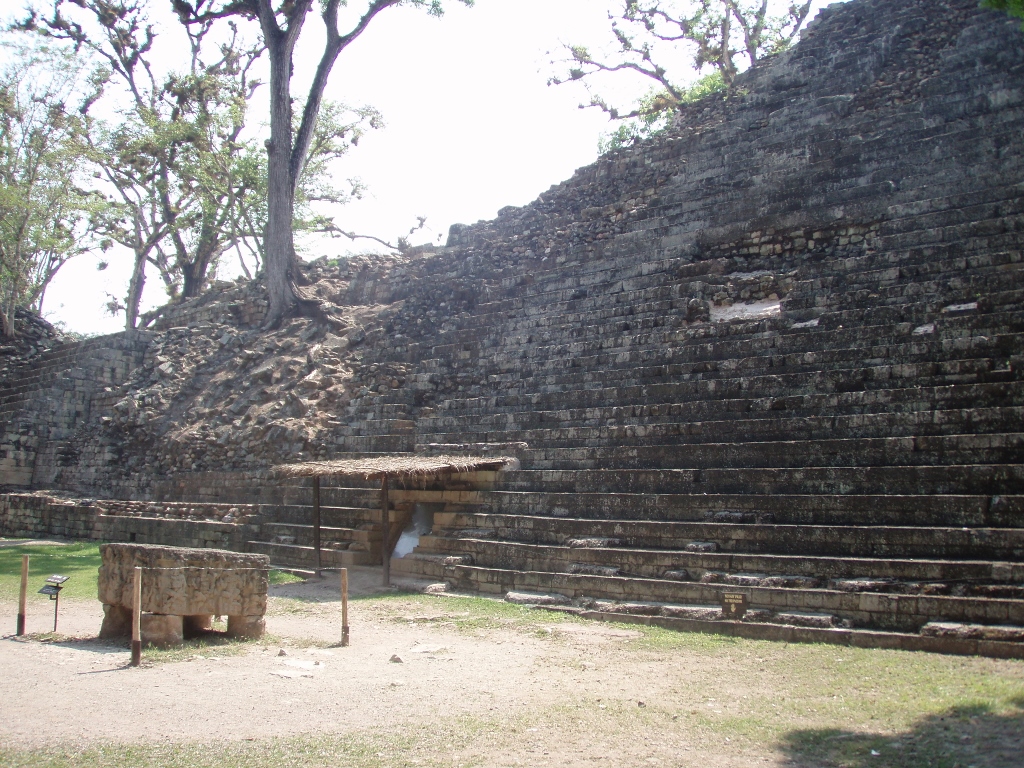 Altar Q and the west staircase of Temple 16
Altar Q and the west staircase of Temple 16
Altar Q has a square base and its importance stems not only from the extraordinary reliefs on it, but also because of its major historic significance: on each side it exhibits four rulers of Copán from that dynasty that developed this city-state and elevated it to the level of one of the most powerful ones within the ancient Maya civilisation. The founder of the dynasty, Kʼinich Yax Kʼukʼ Moʼ, started to rule here in 426, while ruler Yax Pac, during whose reign the altar was made and who is also depicted on the altar, ascended to the throne in 763. Admittedly, as this was already towards the final days of Copán, there are no exact data on the end of his reign, but it is known that it was after 810 CE. After him, there is a “hole” in the data and only one other ruler appears who is known exactly to have ascended to the throne on 6 February 822, while it is believed that he ruled for as long as the city continued to exist and that was until around 830 CE.
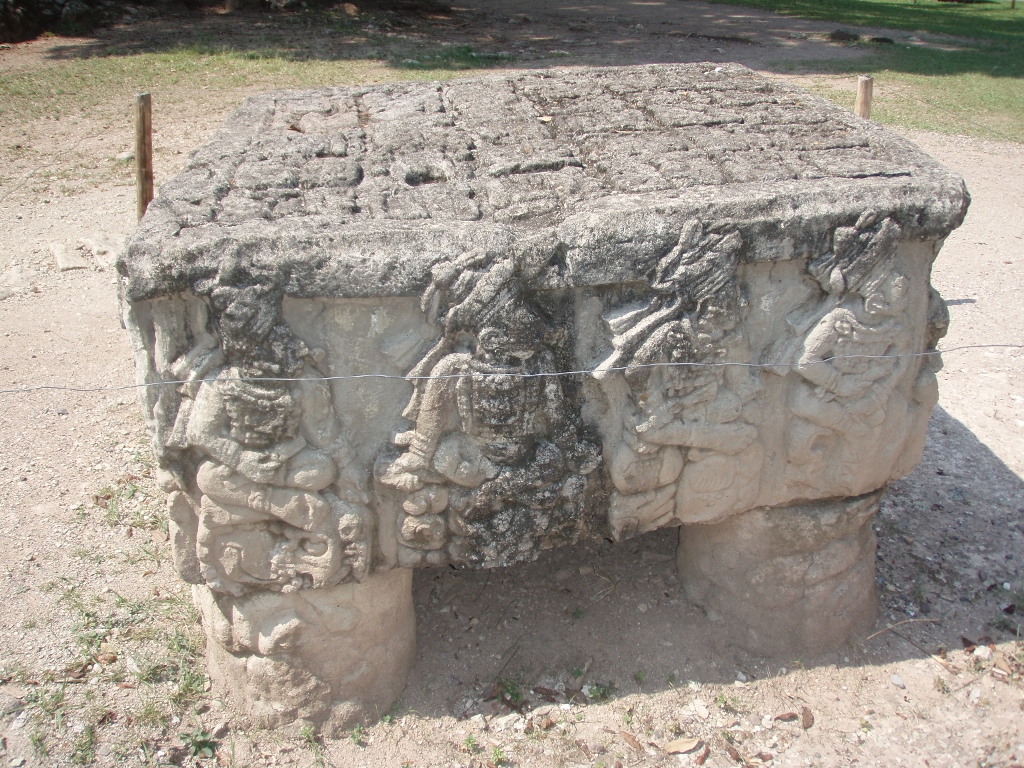 Altar Q
Altar Q
The altar shows the first ruler from the dynasty, Kʼinich Yax Kʼukʼ Moʼ, receiving the ceremonial bar which he transfers further.
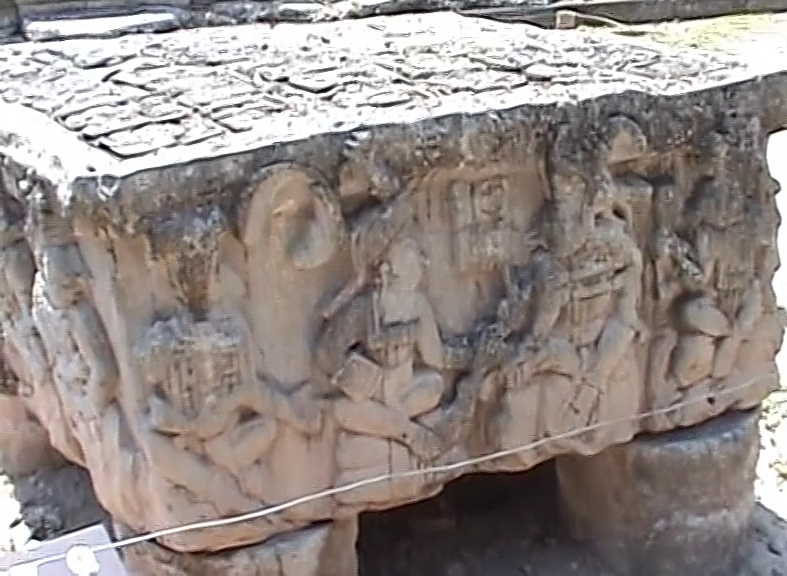 Altar Q, details
Altar Q, details
Behind Altar Q there is a sacrificial vault in which archaeologists have found bones of 15 jaguars and several macaws, so it is presumed that these were the sacrifices offered for the glory of ruler Yax Pac and his ancestors.
While I was standing near Altar Q, I could see nicely the West Court, as well as the south side of Structure 11.
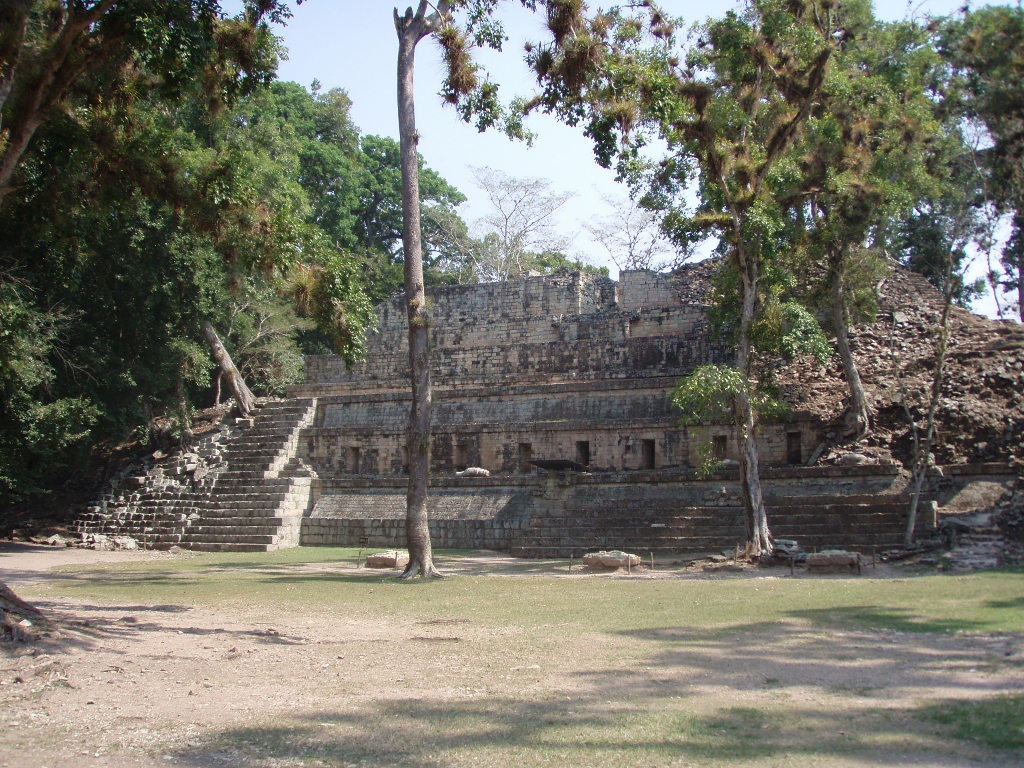 West Court and Structure 11
West Court and Structure 11
The staircase that can be seen along the basis of Structure 11 is called the Tribune of the Spectators. Like in the case of many structures which the Spaniards encountered during their conquests when revealing remains of ancient cities, they must have given this picturesque name because the staircase reminded them of tribunes. There are several details on these stairs, including also numerous ideograms carved on the stone blocks used to make the stairs. As I’ve already said, this is why Structure 11 is often called the Temple of the Inscriptions. Still, the most interesting details are two sculptures that show the storm god presented in the shape of a monkey carrying a torch and having a snake in the corner of his mouth.
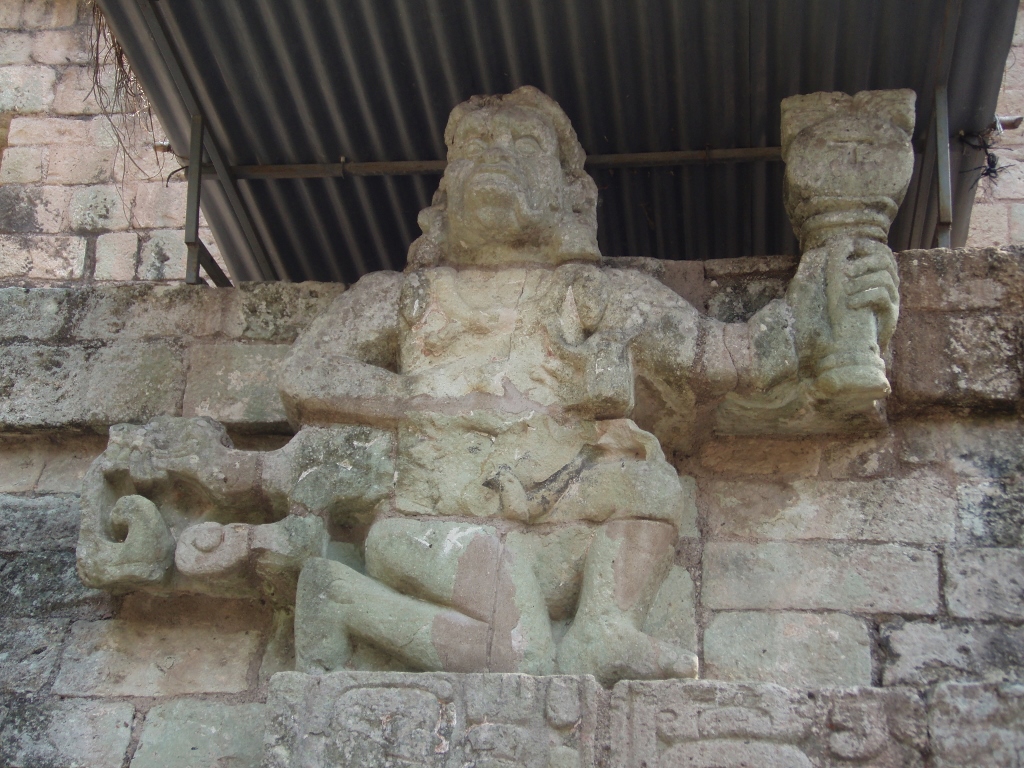 Storm god
Storm god
Here again I took advantage of the presence of another visitor, asking him to take a photo of me standing on the stairs of Structure 11.
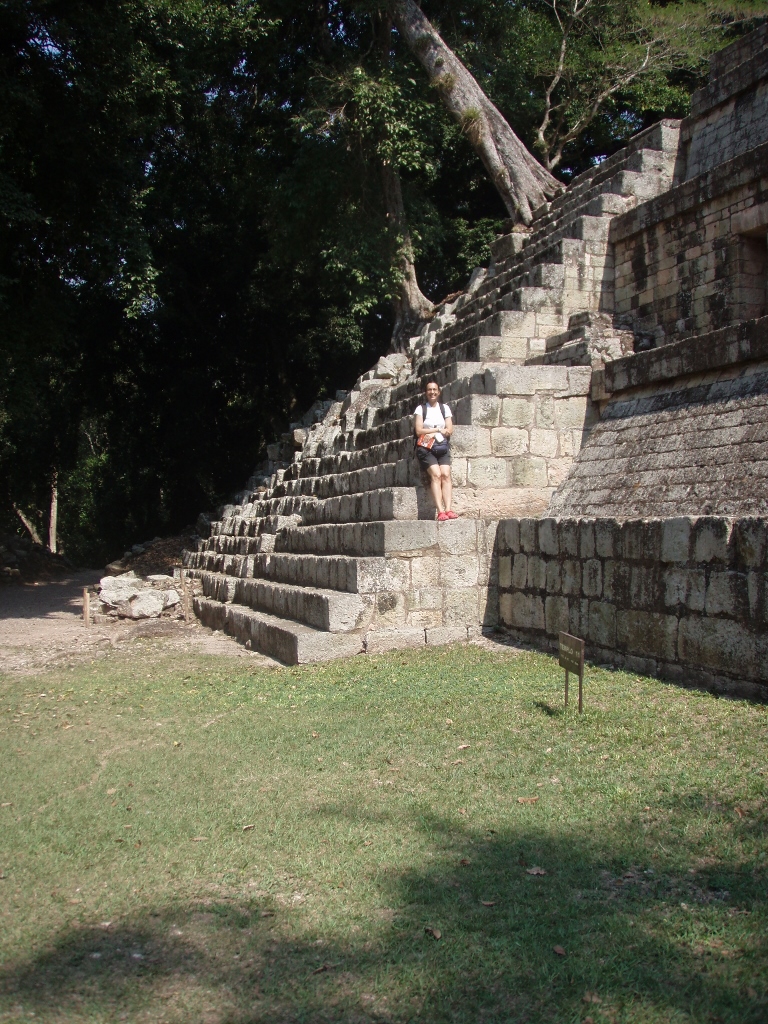 On the stairs of Structure 11
On the stairs of Structure 11
Having thanked him and taking over my photo-camera, I looked again at the Tribune of the Spectators.
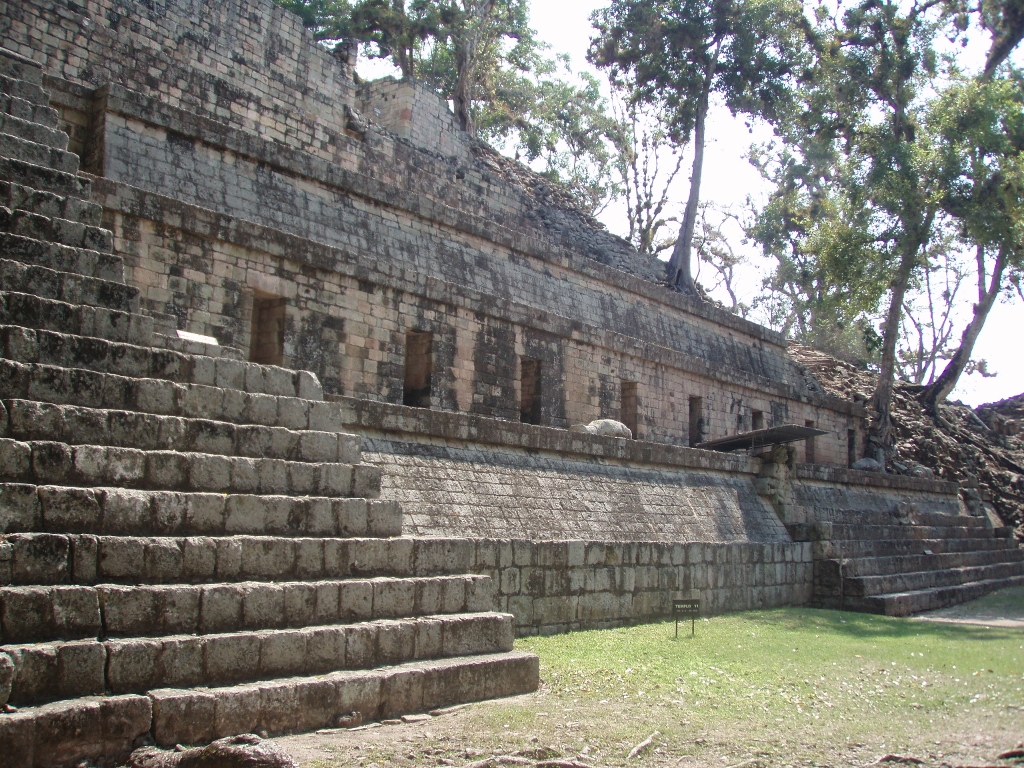 Structure 11: Tribune of the Spectators
Structure 11: Tribune of the Spectators
There, right at the corner of Structure 11 there is also a serpent’s head.
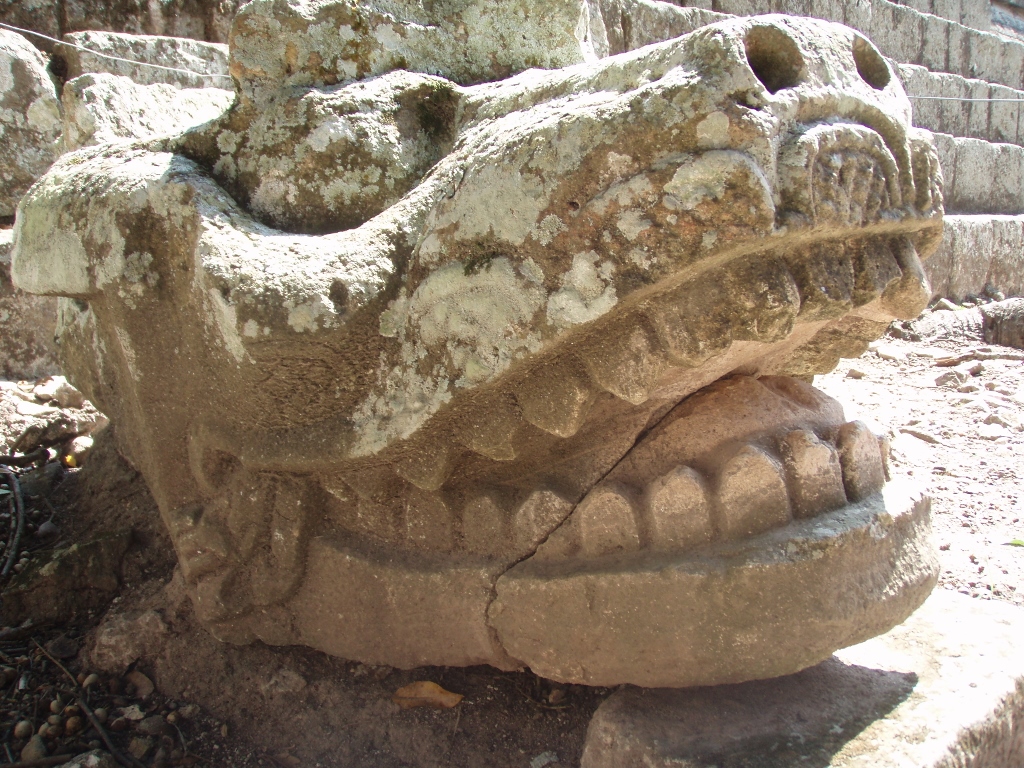 Structure 11: Decoration in the shape of a serpent’s head
Structure 11: Decoration in the shape of a serpent’s head
I also looked back once again at a part of the West Court and Temple 16 which is the highest structure in Copán and which has the shape of a stepped pyramid.
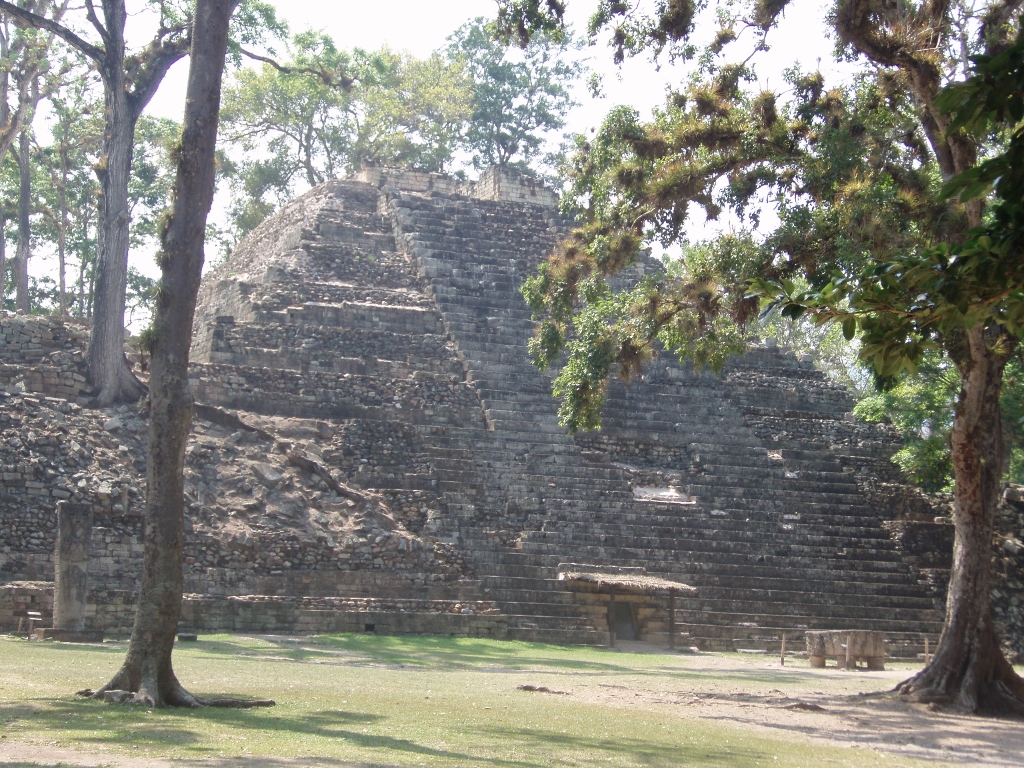 Temple 16
Temple 16
Here I practically completed my sightseeing of the archaeological site of Copán. Following a path that exists here and that leads towards the Grand Plaza I entered a part of the forest where there was a deep shade and this felt very good. While I was standing there I noticed the nests of some weavers, a few smaller birds, as well as a couple of macaws that walked leisurely along a branch. The photo was made from a video recording and it is quite blurry, but the bright red macaws certainly visibly stand out in the sea of green.
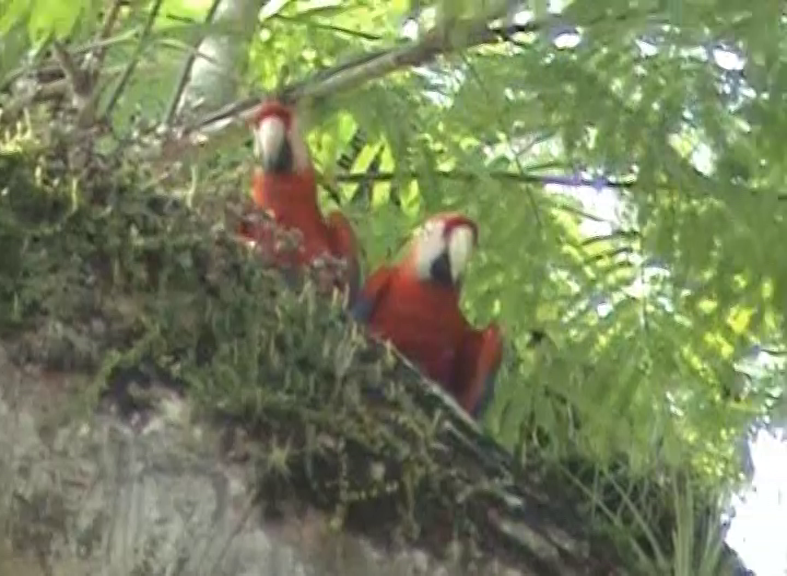 Macaws in Copán
Macaws in Copán
Soon I got back to the Grand Plaza and there in the middle was the stepped pyramid, i.e., Structure 4 which now had visitors climbing to its top.
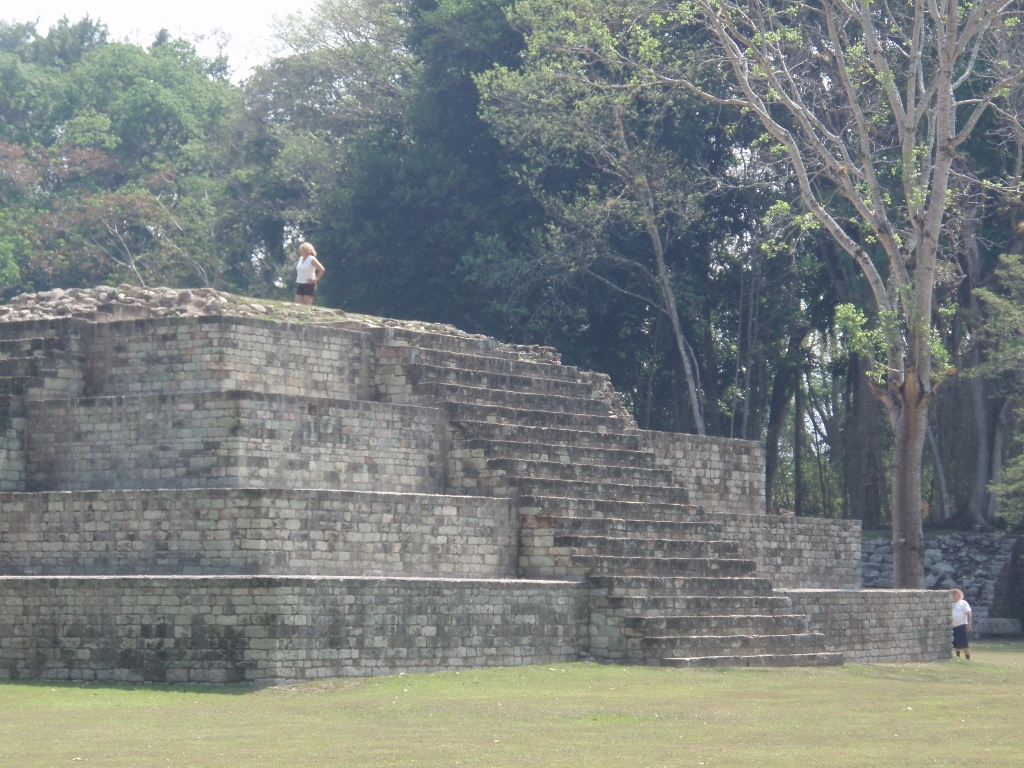 Structure 4 in Copán
Structure 4 in Copán
Before I left Copán, surveying again with my gaze the Grand Plaza and the structures that surround it, I noticed a couple of visitors standing by a tree that grows close to Structure 11. Although Structure 11 itself is unquestionably imposing and I was here to visit and admire the creations of human hands, I could not help admiring the enormous and powerful trees as well. Note the two persons standing left from the tree with the green top in the photo below.
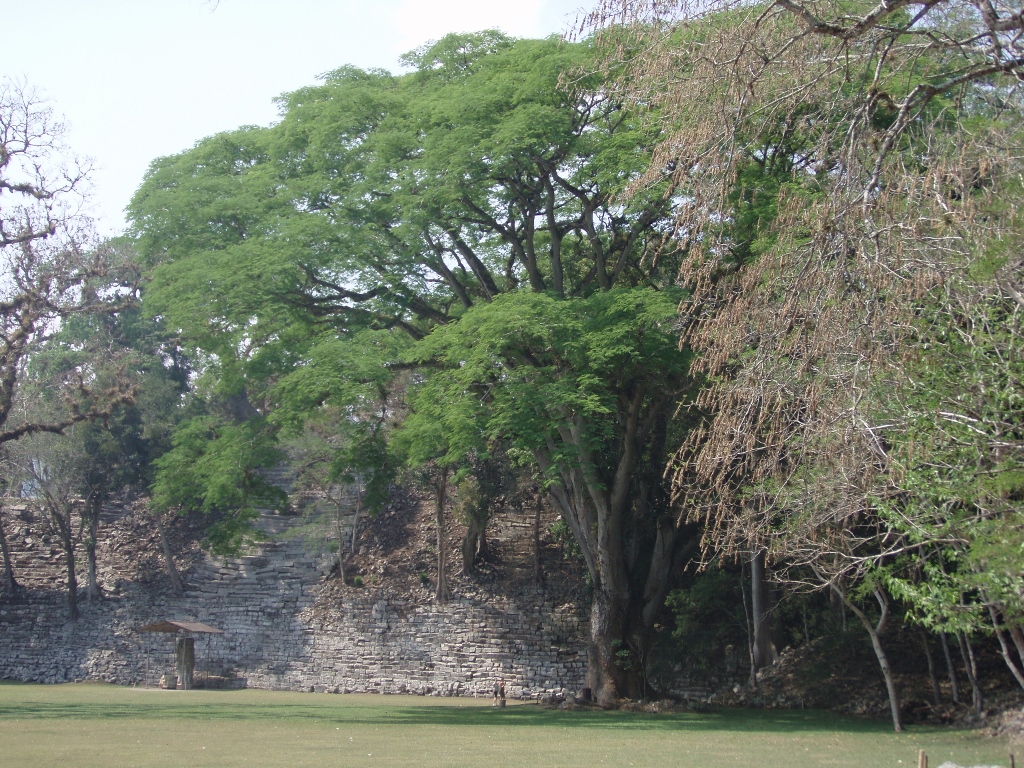 Details from Copán
Details from Copán
As I’ve mentioned before, historically speaking Copán was abandoned seemingly overnight around the year 830 CE. The researchers believe that there was a major famine caused by the deforestation and soil erosion, and this assumption is based on the signs of malnutrition observed in the skeletons found at the site. It is also presumed that on account of the malnutrition, people were more susceptible to different illnesses and then an epidemic easily spread from the starving masses to the members of the elite.
I walked from Copán archaeological site to village Copán Ruinas, since the distance is less than 2 km. Immediately I went to the internet-café to collect my forgotten guidebook that was waiting for me there and then to the post-office to send the postcards. Then I had a late breakfast followed by a mini-break in the hotel room and packing up before the continuation of the journey.
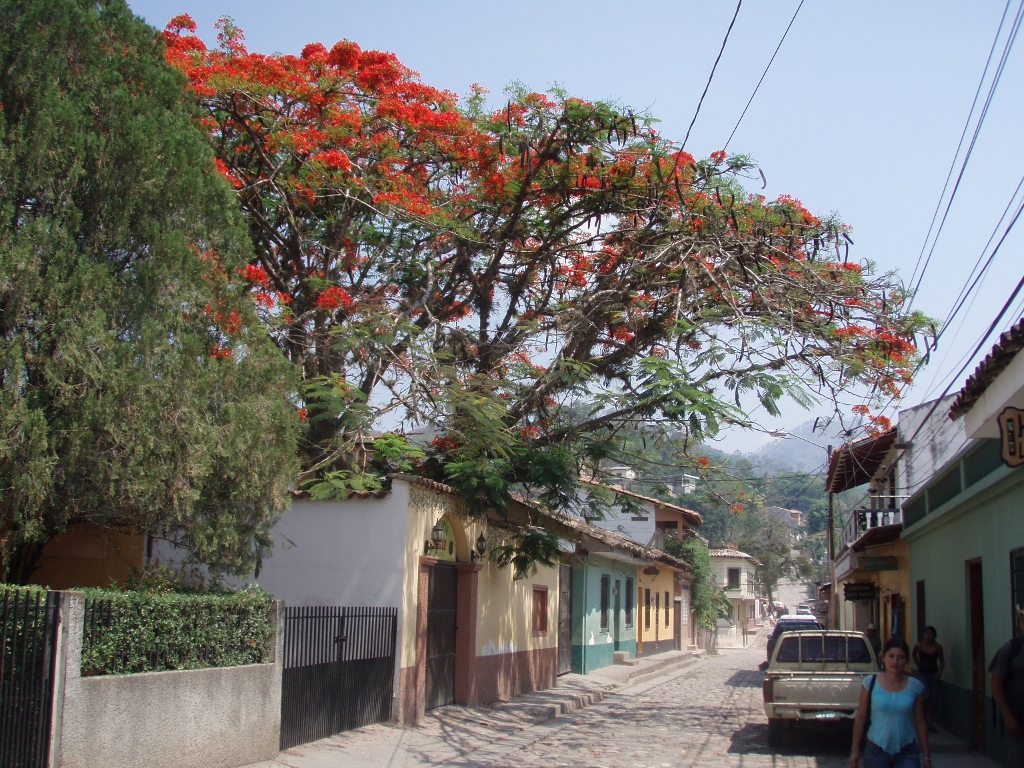 Street in village Copán Ruinas
Street in village Copán Ruinas
Although the site was very interesting and village Copán Ruinas was quite charming, I was fully aware that I had to continue with my travel without any major delay.
When I left the hotel, first I had to inquire where the transportation to Guatemala was leaving from, since that had been changed in comparison to the information I had in my guidebook. And so I got to a corner indicated to me by a woman who said that this was the place from which the passenger vans heading for the border were leaving from. However, after a couple of minutes I was approached by a man who told me that the transportation was leaving from another place that was a little farther. He even took my large backpack to help me. I thought that he probably worked for some transportation company, but as it turned out I was wrong, for he was in fact also a passenger. He told me that he was a farmer, growing maize and beans, but that he was also a pastor (we were speaking in Spanish). In a moment I mixed up the different meanings of the word and first thought that he meant “shepherd” and with a broad smile I asked him if he reared sheep or cattle, thinking that he probably reared cows, since I had not seen any sheep during this journey, plus they would probably die of heat. Then he very kindly and patiently explained that he was a different kind of shepherd, a proper pastor, and it was only then that I realised what this was all about. In my defence, both shepherd and pastor are correct translations of the Spanish word pastor, but it all depends on the context. In any case, I did laugh wholeheartedly at myself for such a blunder.
By the way, during my entire journey around Central America where I mostly transferred from one place to the next by those chicken buses, i.e., the retired US and Canadian school buses, or by passenger vans (especially when I moved between smaller towns and following local roads), I was regularly the only foreigner in them. Since the rest of the passengers would soon realise I spoke Spanish (when I was buying the ticket), our conversations would kick off very soon. My impressions of ALL the people I encountered in these modest means of transportation, irrespective of the country in which I was, were exceptionally positive and good. They were regularly very kind, funnily curious and full of clear desire to help me and give me advice so that I can have as smooth a journey as possible.
As for their curiosity, they wanted to know where I was from, what my profession was, if I had a family in terms of husband and children and since I didn’t they would move to questions about my parents and some would even go so far as to ask me about my parents’ names. I found all of this utterly cute and sweet. I guess some of them were so impressed by my knowledge of Spanish (which is very functional and solid enough, but far from great) that they would ask me if Spanish was spoken in my country. I interpreted this question in the sense that I don’t have a distinct North American accent and from time to time I pronounced “fricative s” that is used in Spain and this probably led my co-passengers to the conclusion linked to the official language in my country.
They also regularly asked me how come I was not afraid to travel alone and if I worried something bad could happen to me while on the road. These were quite legitimate questions especially so since this entire region is traditionally known as quite unsafe and those co-passengers of mine obviously worried about me, regularly emphasising that under no circumstances should l go out on the street in the evening and at night, i.e., when it was dark. Every time I would tell them that I was very careful about my safety, but that I also did not worry too much because “why would anybody want to do me any harm?” At this, they looked at me incredulously with eyes wide open – they must have thought that I was either very naive, very uninformed, perhaps crazy or perhaps even enlightened. In the end I would certainly thank them every time for the advice and their concern saying that I actually did not know what they were like in the evening or at night, but during the day they were all absolutely wonderful!
It was all like this during this stage of my journey, too, and soon a passenger van came by that took us to the border between Honduras and Guatemala which is around 12 km away from village Copán Ruinas. At this point I was parting from Honduras.
I crossed the border that appeared quite deserted on foot and then I caught another passenger van driving in the direction of the town of Chiquimula. In the meantime once again I had to change the passenger van for a bigger one, but that was it. I was back in Guatemala.
In Chiquimula I had to walk a little in order to get to a coach by which I headed for the village of Quiriguá. The day was hot and it was very pleasant on the coach while it was moving, on account of the opened windows, but as soon as it stopped, and it did this relatively often at the stops along the way, it felt as if there were no air and that I would suffocate with heat. The problem was that I had practically left the hilly and mountainous areas and I knew that through the end of my travel I would not have the freshness coming from any higher altitude. But, even in that, there were certain differences and by checking the weather forecast for the following days I knew that the highest temperatures awaited me in the town of Flores from which I planned to visit Tikal. I had to get psychologically ready for that.
Meanwhile I went in the direction of a village that is situated closest to archaeological site Quiriguá that was in fact named after the village. Some dozen minutes before I was to get off the coach a woman started to talk with me and it turned out that she was getting off the coach at the same place as I in order to go to the village. When we both disembarked, she was met there by her husband and then she said they would take me to the hotel and show me the way, which they did. She and her husband were Jehovah’s Witnesses and it was the second year that they were doing their “work” here. As I was helped specifically by some spiritual people on this day, I thought that I must have been very good and so the Universe was sending its “envoys.”
So, once I settled at the hotel, I first had a shower to recuperate from the heat I had been exposed to, since I travelled from 11 am until 5 pm that day, changing who knows how many buses and coaches. Then I went out to go for a walk around the village while there was still some daylight and the temperature at that time of the day was perfect – it was warm, but not overbearingly so, the Sun was mild and I thoroughly enjoyed that stroll.
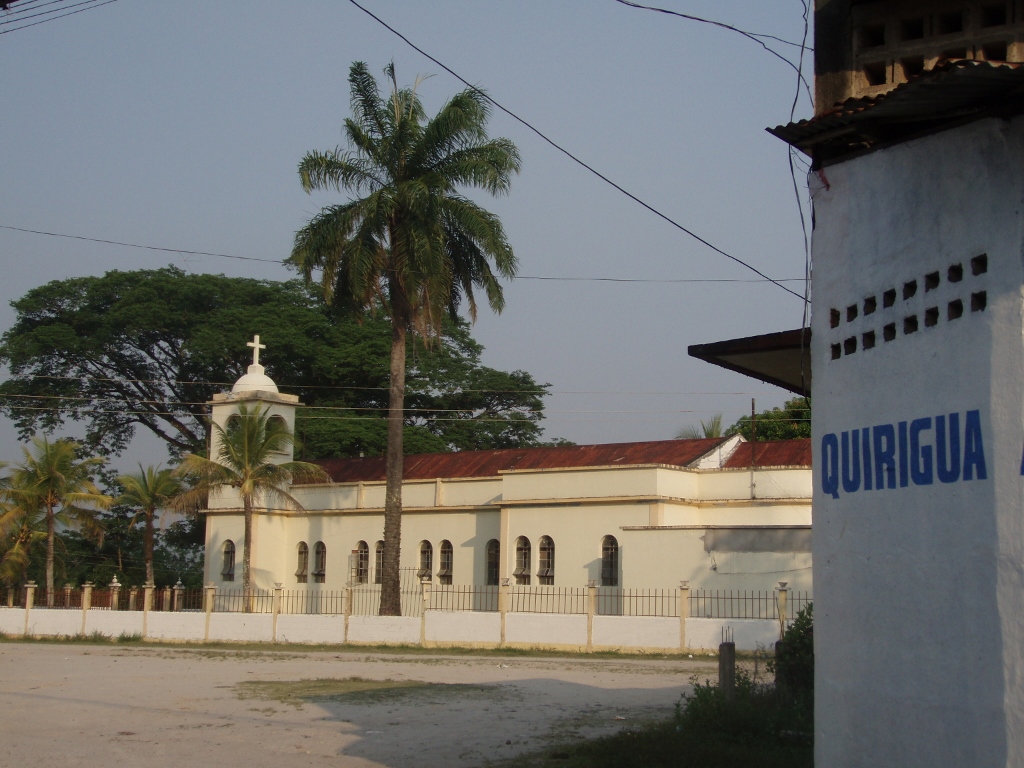 Quiriguá, Guatemala
Quiriguá, Guatemala
I was particularly glad because I was in a small village that had still not been spoiled by the negative sides of the urban human development. Namely, everybody I met – greeted me! With a simple “Good afternoon” (Buenas tardes). I did not find this odd, for many years ago when I went hiking in the backcountry of Montenegro and Serbia I realised that this was a custom in such places that people greeted one another when meeting, regardless of the fact that they did not know each other and that they would certainly never meet again. I was glad to see that this was obviously an omnipresent custom in different parts of the world among the people who still lived in little or not at all alienated places. Of course, I bid “Good afternoon” back to all of these people and sometimes I would be the one to say it first. Then it would be their turn to greet me back. No matter how superficial, this primordial human, deep and noble exchange of good wishes has stuck in my memory as especially pleasant and close to my heart.
During this walk I also went to a shop where there was a public internet (like a small office accessed from the street) in order to check my emails and I also bought water and a few snacks, after which I retired to my room. I had dinner at my hotel and when I wanted to go down to eat I could see on the TV in my room that a series I liked to watch during my journey was beginning. I’ve already mentioned that irrespective of the modesty of the places where I stayed I regularly had a TV set and cable television in my rooms and so I could follow some US channels. This was the case here as well and this felt nice, like a little fun before going to bed, for I did not have any books with me, the books being heavy and by the rule I avoid taking them on the journeys where I constantly move. So, I was hungry and my series was starting. Still, the hunger prevailed and I went down to the dining room where I met the landlady. When she heard of my dilemma she said it would not be a problem at all and she would bring the dinner up to my room! What a service, what a wonderful woman and what a joy! Beautifully relaxed and with pleasantly full stomach, I even watched a film afterwards and then I fell asleep.